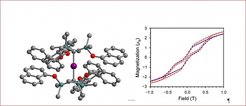Progress on the path to molecule based magnetic storage media
An international team of scientist has succeeded to synthesize and comprehensively characterize a magnetically switchable molecule that thus far had only been predicted by theory. The results lead the way to molecule based magnetic storage media.

Single molecule magnets are subject of intense research efforts due to their ability to switch between two distinct states under the influence of an external magnetic field. Thus, they could potentially pave the way to the miniaturization of storage devices. The ultimate goal in this research field is to rationally design molecules that are switchable at room temperature and retain the stored information in long term. However, in practice, interactions of the molecules with their surrounding lead to a „magnetic shortcut“ and, consequently, to a loss of magnetic information.
M. Atanasov and F. Neese from the Department of Molecular Theory and Spectroscopy at the MPI für Kohlenforschung in cooperation with several groups of synthetic chemists (USA), spectroscopists (Germany) and structural chemists (Denmark), succeeded in synthesizing and theoretically and spectroscopically characterizing and new linear CoII bis-alkyl complex with an unprecedentedly large magnetization barrier. This molecule and its unique properties was theoretically predicted in 2015 by using the powerful and unique tools available through the ORCA quantum chemistry package developed at the MPI für Kohlenforschung. The results have recently been published in Science: http://science.sciencemag.org/content/early/2018/11/14/science.aat7319
Figure: (Left) Molecular structure of Co(C(SiMe2ONaph)3)2. Purple, gray, turquoise, red, and yellow spheres represent Co, C, Si, and O respectively. Hydrogen atoms have been omitted for clarity. (Right) Variable-field magnetization data show hysteresis behavior and hence prove that the system is magnetically switchable.












